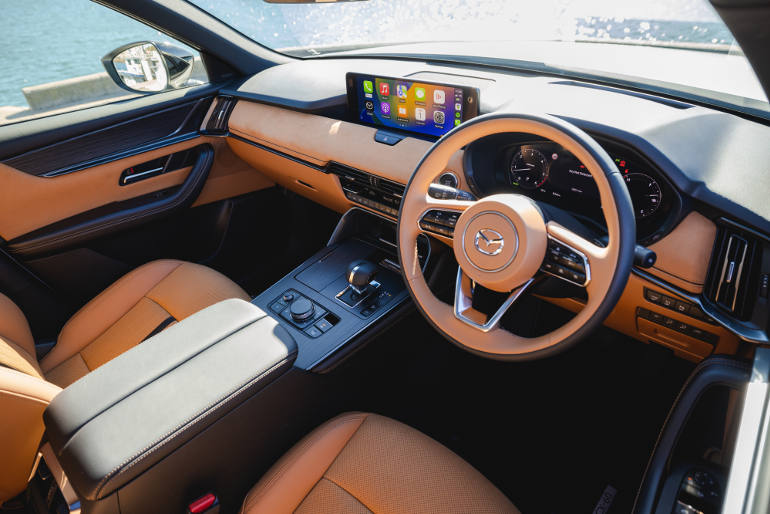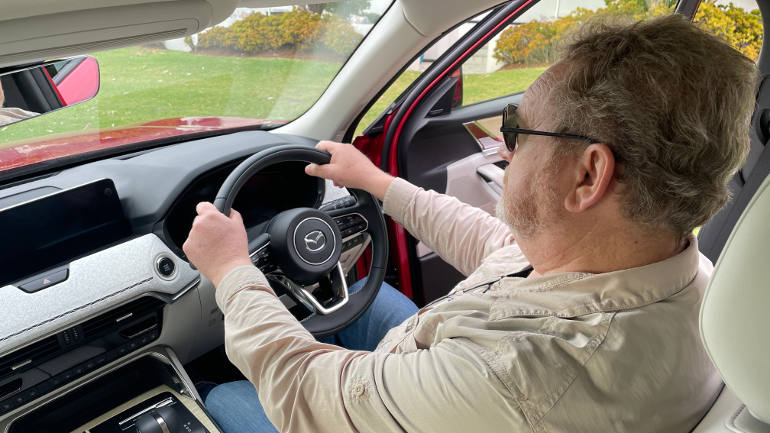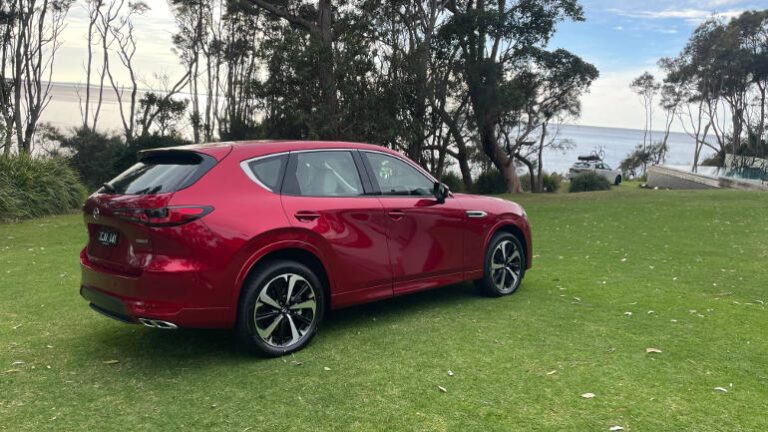Mazda is taking measured steps towards electrification while not abandoning the development of internal combustion engines. They have just launched a new medium size SUV, the CX-60 with all models having mild hybrid power trains.
Mazda already has a model in the medium size SUV segment, the CX5, which is classified as chiefly priced below $60,000.
The CX-60 is clearly pitched as a premium model which is an image that Mazda is unashamedly targeting.
Being in the above $60,000 category in the industry sales figures (VFacts) obviously means it is not a general runabout fleet vehicle, but could be a senior manager’s car, and/or suited to novated leases, without going to more expensive brands that can hint at excess in some people’s mind.
With hybrid powertrains this could also suit a more environmental approach, but the electric power assistance is only mild and does not achieve class leading fuel economy.
Exterior Design
The Mazda CX-60 remains conservative in its style, particularly from the rear and keeps lines, angles and creases to a relatively subdued level without looking bland. The grille and the badging help identify it as a Mazda.
Some recent SUV models from other brands are being more adventurous moving away from the common, understated SUV shape. Aggressive fascia designs and the use of modern lighting options are part of this shift. Hyundai’s IONIQ5 and some electric vehicles are significantly expanding the design envelope.
Customers have a choice of seven colours including white, silver, grey and black. The most striking colour is “Soul Red Crystal Metallic” while “Deep Crystal Blue Micra” gives a sophisticated look.
Powertrains
The CX-60 comes with three powertrain choices, all with mild 48V electric hybrid assistance.
There are two new internal combustion engines. Both are 3.3litre in-line 6-cylinder turbo engines; one’s a petrol and one’s a diesel. The third powertrain is a PlugIn Hybrid with a 2.5 litre 4-cylinder turbo petrol engine.
Every model has all-wheel-drive. The Power figures for each are as follows:
| Powertrain | kW | Nm |
| 6 cylinder, 3.3 litre turbo petrol with mild hybrid | 209 kW @ 5,000-6,000 rpm (max. power) | 450 Nm @ 2,000-3,500 rpm (max. torque) |
| 6 cylinder, 3.3 litre turbo petrol with mild hybrid | 450 Nm @ 2,000-3,500 rpm (max. torque) | 550 Nm @ 1,500-2,400 rpm (max. torque) |
| 2.5L I4 e-Skyactiv PHEV | 241 kW @ 6,000 rpm (max. power) | 500 Nm @ 4,000 rpm (max. power) |
In-line six-cylinder engines have come back into favour in some premium brands and Mazda says they are “the most naturally balanced engine configuration”. Many would agree.
On a secondary road with flowing or even tighter, twisting corners, the new powertrains do sound and feel good, and fit into Mazda’s “zoom-zoom” marketing message. They do not have the massive “punch in the back” acceleration of a full electric vehicle, but they accelerate with confidence. It is also comforting that the car gets the power to the ground in a solid and safe manner such as when having to overtake on single lane roads. It is in the open road situation that the CX-60 best shows its credentials.
The engines are coupled to an 8-speed automatic gear box which is a little different in its design. Mazda defines it as “This new transmission shifts gears in the same manner as a torque converter-equipped transmission – via planetary gears and multi-plate clutches – but it does not have a hydraulic converter as an input coupling; instead, it uses a multi-plate clutch as well as an integrated electric motor/generator”.
Mazda says that they powertrain layout helps the smooth mixing of the petrol and hybrid motors.
The 8-speed gearbox certainly seems smooth but in a few urban situations there were the occasional noticeable “clunk” when slowing down. The integration of the internal combustion engine, the electric hybrid system and possibly the gearbox needs some refinement.
The cabin noise and ride quality were more noticeable than might have been expected. Not excessive but not class leading. In the initial drives, the vehicle seemed most at home in sport mode in rural areas.
The mild hybrids, particularly with the six-cylinder petrol engine, do not improve fuel consumption figures to the extent of some more developed systems of other manufacturers.
The rated figures from standard tests are as follows although we recorded poorer numbers (as is often the case in everyday driving) on the launch drive.
| Electrification | M Hybrid Boost (48V mild hybrid) | M Hybrid Boost (48V mild hybrid) | Plug-In Hybrid (PHEV) |
| Fuel consumption (l/100km): | |||
| combined | 7.4 | 4.9 | 2.1 |
| extra-urban | 6.0 | 4.7 | — |
| urban | 9.8 | 5.2 | — |
| CO2 emissions (g/km): combined | 171 | 128 | 49 |
Interiors

The interiors come in one of three levels: Evolve, GT, and Azami.
The general overall cabin feel is one of a mature product. There are some option pacts, for the Azami variant that make for more vivid interior colours such as the bright tan upholstery in the SP package and the Pure White Nappa leather seat trim and cloth dashboard panel with Kakenui stitching in the Takumi Package.
The dash/infotainment layout is well set out and avoids excessive, distracting information. The Head Up Display is very good with clear numbers and instructions and is standard on all models.
The list of comfort and safety feature are in line with their competitors. It is good to see that along with the usual items, a range of features are standard across the whole range including:
- LED headlamps with auto on/off and High Beam Control
- Remote operated power tailgate (open/close)
- Dual-zone climate control with rear vents
- Satellite navigation
- Smart Brake Support (SBS) with Turn-across traffic
- Apple Carplay and Android Auto (wireless and USB)
- Wireless phone charger
- The Azami has both heated and cooled front seats. Cooled seats seem to me to be an excellent feature for Australian conditions, but then again, the Koreans have had this in their up-spec models for some time.
Some safety features such as rear cross traffic alert are standard on the Azami, but you need to get the $2,000 Vision Technology Package to get it on the Evolve and GT models.
The PHEV has a few interesting standard features:
- 12.3-inch TFT LCD multi-information meter display
- Rear power outlet socket with 1,500W AC
Pricing
The base model Evolve is priced (excluding on-road costs) for each powertrain at:
- Petrol – $59,800
- Diesel – $61,800
- PHEV – $72,300
To upgrade to the GT adds $8,000
To upgrade to an Azami is a further $5,200 ($13,200 over the base model)
This makes the range of prices from $59,800 to $85,500 plus on road costs.
Conclusion
Mazda is confident that they appeal to a wide range of market segments including performance (zoom-zoom), lifestyle and conservative buyers. They are the second biggest selling brand in Australia which would appear to bear this out.
The CX-60 medium SUV continues their on-going development of internal combustion engines but early development of hybrid technologies.
The vehicle looks the part of a mature, premium car. The interior options on the top-spec models stand out more clearly.
For fleet markets it would suit an above average vehicle with the appearances of solid, credibility without spending on more perceived luxury brand names.









